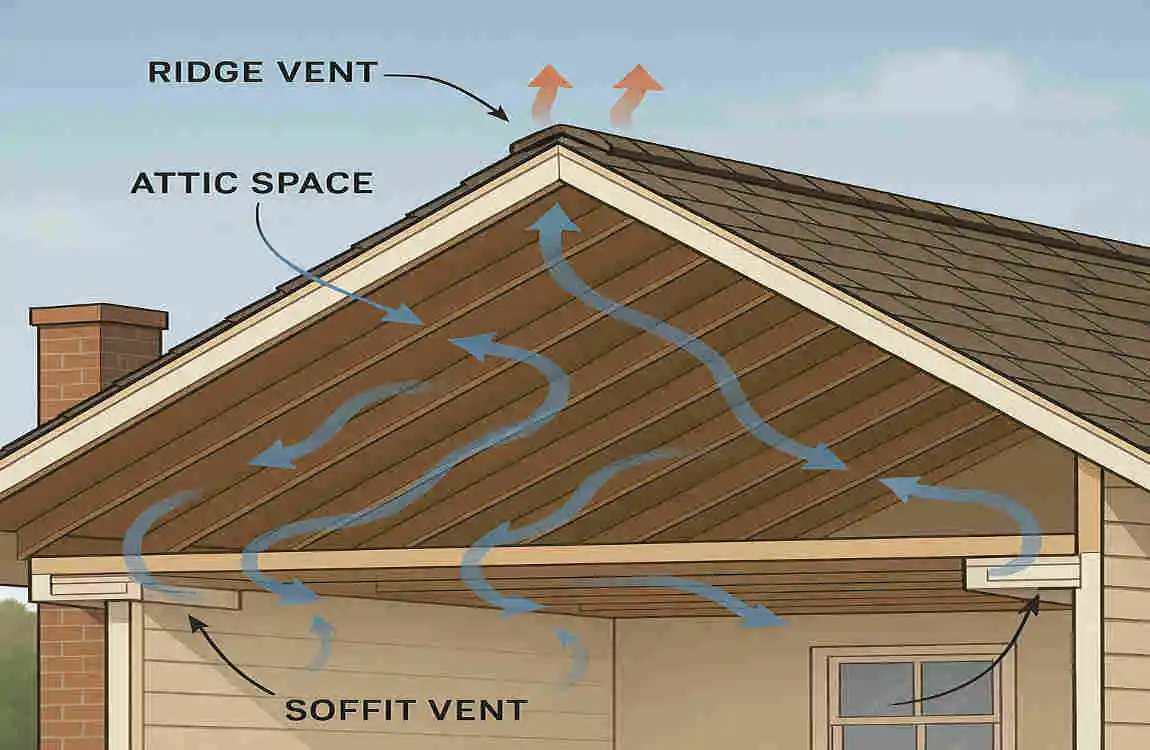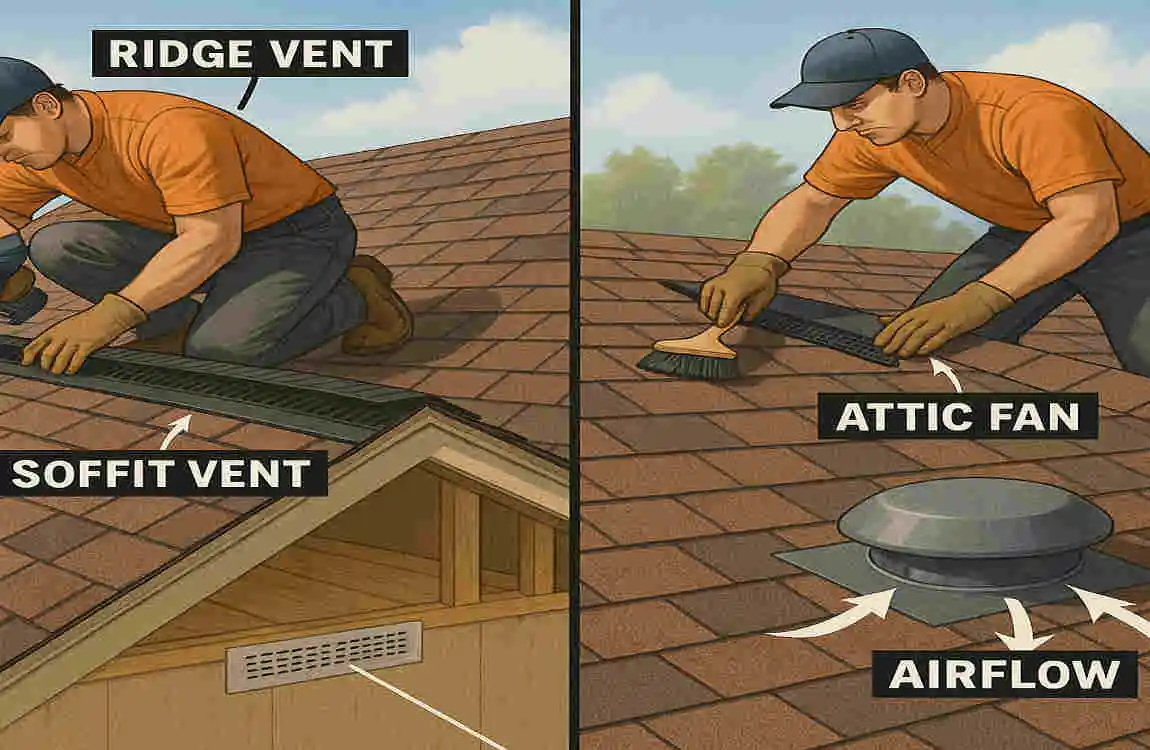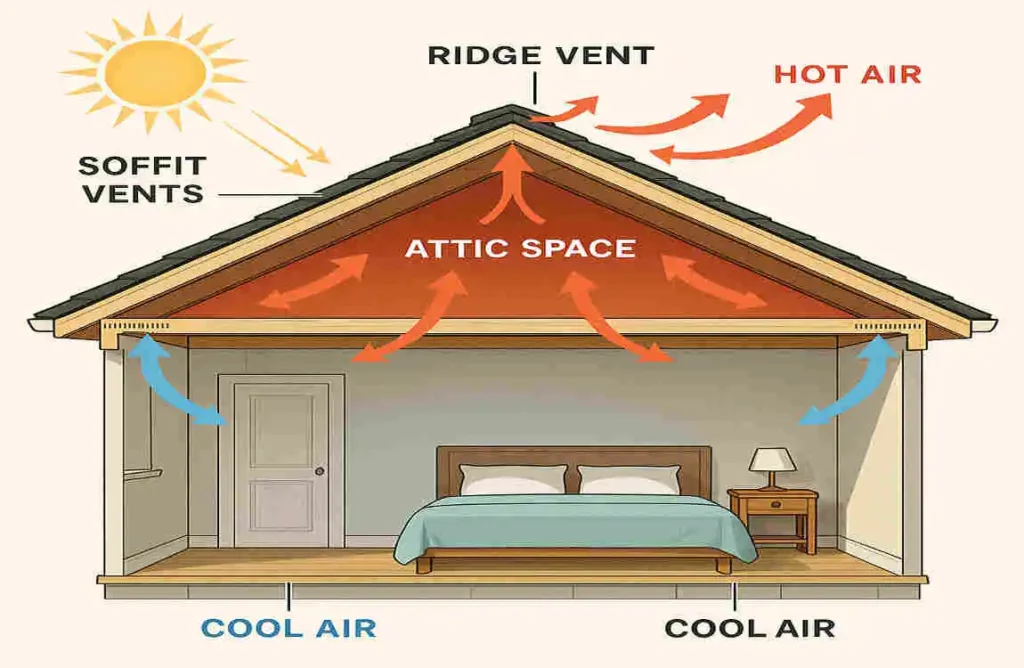Proper roof ventilation is one of the most vital yet often overlooked aspects of home maintenance. Whether you’re a homeowner or someone exploring the specifics of sustainable housing, understanding how a roof ventilation system works is key to maintaining a healthy, energy-efficient, and long-lasting home.
Why Roof Ventilation Matters

The Role of Roof Ventilation in Modern Homes
Roof ventilation plays a critical role in regulating temperature, managing moisture, and maintaining airflow in your home. Without it, your attic or roof space becomes a breeding ground for problems such as mold, structural decay, and energy waste.
Core Benefits of Roof Ventilation:
- Moisture control: Prevents mold, mildew, and wood rot.
- Temperature regulation: Balances indoor temperatures during summer and winter.
- Energy savings: Reduces dependency on heating and cooling systems.
- Extends roof life: Protects shingles and other roofing materials from extreme weather damage.
Now, let’s dive deeper into the mechanics of roof ventilation.
What Is Roof Ventilation?
Roof ventilation refers to the process of allowing air to flow freely through your attic or roof space. It’s an essential design feature in modern homes that ensures proper air circulation while preventing moisture buildup.
Roof Ventilation vs. Attic Ventilation
While roof and attic ventilation are closely related, they serve slightly different functions. Roof ventilation focuses on the roof structure itself, ensuring that hot air escapes and fresh air enters. Attic ventilation, on the other hand, refers specifically to the airflow within the attic. Together, they form a comprehensive system that protects your home.
Why Ventilation Is Critical in All Climates
Whether you live in a hot, humid climate or a cold, snow-prone region, roof ventilation is essential. For example:
- In hot climates, Ventilation prevents heat buildup, reducing strain on your air conditioning system.
- In cold climates, it prevents condensation and the formation of damaging ice dams on your roof.
How Does a Roof Ventilation System Work?
A roof ventilation system works based on the principles of airflow: intake and exhaust.
The Fundamentals of Airflow
- Intake Vents: These bring fresh, cool air into the roof space from the outside.
- Exhaust Vents: These allow hot, moist air to escape.
When properly balanced, this continuous airflow helps maintain a stable environment in your attic.
Natural vs. Mechanical Ventilation
- Natural ventilation relies on wind and convection to move air through the roof.
- Mechanical ventilation uses powered fans to enhance airflow, especially in homes where natural airflow isn’t sufficient.
The key to an effective system is balancing intake and exhaust to prevent moisture buildup or overheating.
Components of a Roof Ventilation System
A roof ventilation system consists of several components, each with a unique role in maintaining airflow. Let’s break them down:
Intake Vents
- Soffit vents: Located under the eaves of the roof, allowing cool air to enter.
- Eave vents: Similar to soffit vents, these are found at the roof’s edge.
Exhaust Vents
- Ridge vents: Run along the roof’s peak and allow hot air to escape.
- Gable vents: Installed on the gable ends of the roof for additional exhaust.
- Roof turbines: Use wind power to pull hot air out of the attic.
- Box vents: Static vents installed in specific roof areas to release heat and moisture.
Additional Components
- Baffles: Prevent insulation from blocking air pathways.
- Attic fans: Mechanical devices that actively push hot air out of the roof space.
Each component plays a critical role in ensuring the system’s efficiency and balance.
Types of Roof Ventilation Systems
Roof ventilation systems come in various types, depending on how they operate:
Passive Ventilation Systems
These systems rely on natural airflow, using convection and wind to move air through the roof space.
Pros:
- Energy-efficient (no electricity needed).
- Low maintenance.
Cons:
- Ineffective in homes with poor airflow or complex roof structures.
Mechanical Ventilation Systems
Powered by electricity, these systems use fans to actively move air in and out.
Pros:
- Ideal for homes with limited natural airflow.
- Can handle extreme heat or moisture conditions.
Cons:
- Higher installation and operational costs.
Hybrid Systems
Combining passive and mechanical components, hybrid systems offer the best of both worlds. They’re highly efficient and customizable based on your home’s specific needs.
How Roof Ventilation Impacts Home Health
A well-ventilated roof contributes to your home’s overall health in many ways:
Moisture Control and Mold Prevention
Without proper ventilation, moisture from daily activities like cooking and showering can accumulate in the roof space, leading to mold growth.
Ice Dam Prevention in Cold Climates
In snowy regions, inadequate ventilation leads to uneven roof temperatures, which in turn cause ice dams. These can damage shingles and gutters.
Protection from Structural Damage
Excess moisture weakens wooden beams and other structural components, leading to costly repairs.
Improved Indoor Air Quality
Ventilation removes stale air and pollutants, creating a healthier living environment for your family.
Energy Efficiency Benefits of Roof Ventilation
If you’re looking to lower your energy bills, a roof ventilation system can be a game-changer.
Reduced Cooling Costs
By allowing hot air to escape, ventilation reduces the strain on your air conditioner during summer.
Consistent Indoor Temperatures
A balanced system prevents temperature fluctuations, making your home more comfortable year-round.
Prolonged HVAC Lifespan
Less strain on your heating and cooling systems means they’ll last longer, saving you money on replacements.
Lower Energy Consumption
By reducing the need for artificial heating and cooling, ventilation lowers your energy use and carbon footprint.
Signs You Need to Improve Roof Ventilation
Is your current ventilation system doing its job? Watch out for these warning signs:
- Skyrocketing energy bills indicate your HVAC system is overworking.
- Attic heat buildup: If your attic feels like a sauna, ventilation may be insufficient.
- Mold or mildew: A sign of trapped moisture.
- Ice dams: Common in winter when ventilation is poor.
How to Inspect Your System
- Check for blocked vents or insulation issues.
- Observe attic temperature and moisture levels.
- Consult a professional if you’re unsure about your system’s condition.
Installation and Maintenance Tips

Proper installation and regular maintenance are key to a long-lasting ventilation system.
Seasonal Maintenance Checklist
- Clean debris from vents.
- Check for blockages or damage.
- Inspect attic insulation and baffles.
DIY vs. Professional Installation
- DIY: Cost-effective but requires technical knowledge.
- Professional: Ensures optimal placement and sizing of vents.
Common Myths About Roof Ventilation
Ventilation Causes Leaks
Fact: Proper ventilation prevents leaks by reducing moisture buildup.
More Vents Are Always Better
Fact: Ventilation needs to be balanced, not excessive.
Attic Fans Are Necessary for All Homes
Fact: Attic fans are helpful but not mandatory for every home.
Environmental Impact of Roof Ventilation
Roof ventilation isn’t just good for your home—it’s also good for the planet.
- Green building standards: Many eco-friendly homes prioritize ventilation.
- Carbon footprint: Reduces energy consumption, supporting sustainability.
- Eco-friendly materials: Opt for sustainable vent components for an even greater impact.
